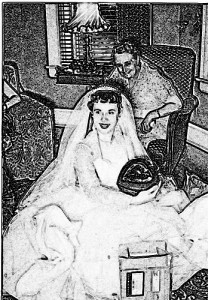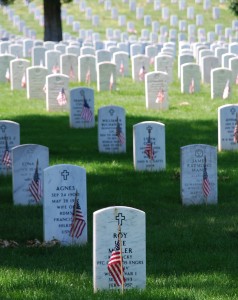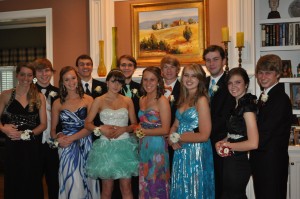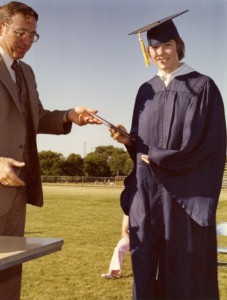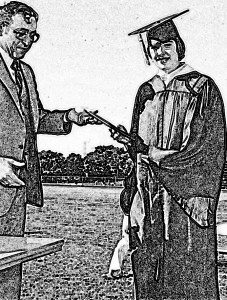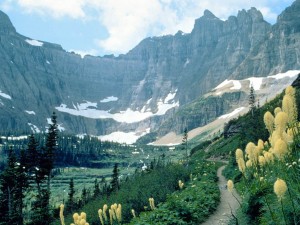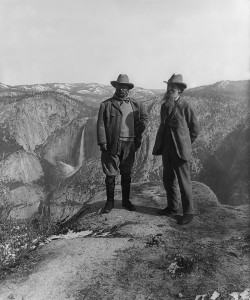1. Where was this picture taken?
This picture was taken in a house (living room).
2. Who do you see in this picture?
We see a young lady, and an old woman.
3. What are the people in this picture doing?
The young lady is holding a present, and the old woman is watching her.
4. What kind of clothes are the people in this picture wearing?
The young lady is dressed in a bridal gown. The older woman is dressed up.
5. What is the young lady in the picture holding?
She is holding a heart-shaped present of some sort.
6. What kind of emotions do you think the young lady has?
She is probably happy and excited.
7. What kind of party is this?
This is a wedding shower, or a bridal shower.
8. Who is probably the hostess for the party?
The hostess for the party is probably bride’s maid of honor.
9. Who else might help the hostess with the party planning and preparations?
The bridesmaids and maybe the bride’s mother might help the hostess with the preparations for the bridal shower.
10. Who would be invited to this party?
The people that would be invited to the bridal shower would be the bridesmaids, the mother of the bride and other female relatives of the bride, and other female friends of the bride.
11. Would there be any male guests at this party?
No, there are usually no male guests at a bridal shower.
12. Why are there usually no men at a bridal shower?
There are usually no men at a bridal shower, because most men would find it boring to be at a party with a group of ladies talking about things that interest women.
13. Would there be any children at a bridal shower?
There probably would not be any children at a bridal shower, because they would not find it interesting and become easily bored.
14. What types of presents would the guests bring?
For a bridal shower, the guests usually bring presents that help a bride to set up housekeeping – presents like small kitchen appliances (toasters, mixers, etc.), linens (towels, bedclothes, etc.), and other handy things for the home.
15. How do the guests know what types of presents would be good for the bride-to-be?
The guests can get a good idea of what would be good presents for the bride-to-be by consulting the bridal couple’s gift registry, or wish list, if they have registered such a list at a store.
16. What sort of decorations would be appropriate for this kind of party?
Appropriate decorations for a bridal shower would be wedding-themed, with hearts or turtle doves, white and other pastel colors, wedding bells, and so on. There are also usually some small party favors for the guests.
17. What sort of food would be appropriate for this kind of party?
Cake, punch, and light snacks such as appetizers and hors d’oeuvres would be appropriate for a bridal shower.
18. What sort of activities would be appropriate for this kind of party?
The kind of activities that would be appropriate for a bridal shower would include fun, light-hearted games that help “break the ice,” giving the women a chance to socialize and chat with one another.
19. How could the bride-to-be keep track of who gives her which presents?
The bride-to-be can keep track of who gives her which presents by keeping any tags or cards with the presents. It will also help her if the hostess writes a list of the presents, and who they are from.
20. After the shower is over, how can the bride express her gratitude for all the presents she has received?
After the shower is over, the bride can express her gratitude by sending thank-you notes to all the people who gave her the presents.
Paragraph: At a Wedding Shower
When I got married, my maid of honor had a bridal shower for me. The shower was held a few days before we got married. Everybody met at my house for the shower. There were appetizers and snack trays with carrot sticks and other vegetables for people to eat, along with some cake and punch. In the middle of the table was a lovely floral centerpiece. My friends came to my shower. There were many presents for me to open, and it was nice of everyone to think of me and help me get ready for married life by giving presents to help furnish the kitchen and the house. After opening the presents, there was a lot of talking with all the women there. Many of them had some advice for me as a bride-to-be. I was thankful for my maid of honor to host the wedding shower for me, and I was thankful for my friends helping me to get ready for this new phase in my life.


